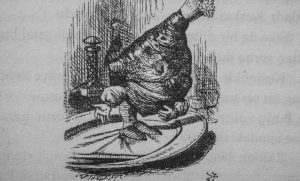In this article I will try to illustrate what I know to be a service designer with the help from the protagonist in Shape of Water.
SERVICE DESIGN IS LIKE WEATHER PREDICTION
Desiginig starts with the power to empathize. Learning to empathize takes practice, and converting what you cultivate into a meaningful service is a lot like weather prediction: A total chaos. But we will not get in to the chaos theory just now, instead I want to review the protagonist Elisa Esposito to storify service design, so here we go.
 Illustrator: John Tenniel
Illustrator: John Tenniel
A PRINCESS WITHOUT A VOICE
Our heroine Elisa is without a voice -she is found as an orphan with wounds around her neck- and serves as a cleaning lady in a secret government laboratory.
She is nobody significant, neither beautiful, young or gifted, without any tangible assets; She is transparent, so to speak.
Shape of Water is a film noir, but Elisa seeks color and light all the time: She gazes longingly to a pair of red shoes on a shop window, she dances. She has no artistic claims, but she is creative, we find out more about her creativity later in the movie when she smuggles a beast out of the government laboratory.
What makes Elisa special is the fact that she cannot talk. The fact that she can’t talk gives other characters in the movie more room to express themselves which allows her to master listening. Even when they are talking to her, it feels like they are talking to themselves. She finds neither Zelda’s (her co-worker ) problems with her husband, nor her old neighbor Giles’ despair to a bartender silly or insignificant. She simply pays attention. Her long years practising how to listen makes her the best designer. She is a like a messenger who pilots a starship, she would convey messages seamlessly without her ego getting in the way.
THE TWO APPROACH
In the second act we are introduced with the monster of the tale when the facility Elisa works receives a new arrival called the ’Asset’. How the organization where Elisa works tries to ‘deal with this problem’ is significantly different than our heroine’s approach. ‘The facility leaders’ are frightened by this creature that is beyond their conventional understanding. Amphibian Man is tortured and imprisoned, eventually sentenced to death, simply because they don’t know what to do with him, and their fear grows into frustration whereas Elisa is calm and curios. She is brave enough to make a fool of herself, to even try to form some kind of a dialog with a phenomenon. She assumes the basic needs of an amphibian, but she does not pushes them. She doesn’t suggest ‘the language’, she gestures.
It is extremely relevant to our topic that Elisa is opposite of anyone vocal. She communicates with her moves, directs master plans with her body, and not with her voice. Communication needs to be straight-forward, brief and extremely effective for her, it’s not something she particularly finds joy in. She is not susceptible to words thus not easily manipulated by them. She is less inclined to be defined with her mind than any other. That is the key to master service. She doesn’t express herself while communicating, she simply conveys meaning, without getting caught in self expression. Elisa designs a plan to save the Amphibian Man. Like many other service designers, she has a team. She asks help from her neighbor Giles, who then becomes the creative director of the plot. She gets him involved by teaching him how to empathize with the creature.
It is no coincidence that the protagonist is a she and the director Guillermo del Toro was born in Guadalajara Jalisco, Mexico: The monster in the story is found by a river in the wilderness of South America, where it was worshipped as a god. What needs to be saved in the story is a wild god in the form of a male amphibian and the protagonist is a woman in service: Over time in western culture, the wild, unpredictable, uncountable, dangerous and odd (what are in fact is creative, playful, circular, curious, accepting of change and what’s new, fluid and adaptable, invisible and instinctive) became the laughing-stock: the primitive- what was needed to be left behind. We got used to be in war with chaos. We dissected it into smaller, detached and countless number of problems, supposedly to tack it better. We became too involved in deconstructing of the universe that we lost track on connecting dots to create meaning.

Illustrator: John Tenniel
TO CONCLUDE
Now it’s time we start getting our hands dirty with chaos, get jiggy with never ending research, ease ourselves into circulating patterns.
At the end of the movie both Elisa and the Amphibian Man die.
If we need to die to reborn with wings, let’s die. The chances are we will gain a more balanced vision to design better, if we do.

